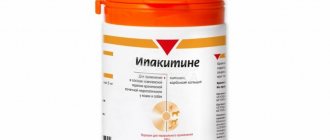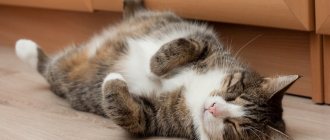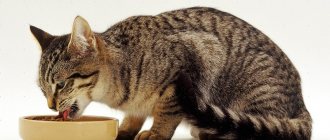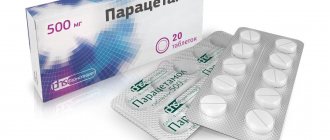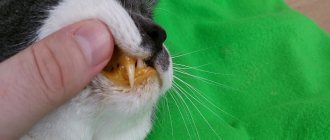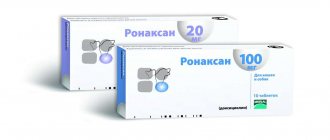In veterinary medicine, the drug "Eufillin" for cats has been used for many years. It has established itself as a highly effective medicine with a pronounced bronchodilator and vasodilator effect. The Latin name of the drug is Euphyllin. The instructions for use describe in detail how to give it to pets, but before you start using Eufillin for cats, you should consult a veterinarian.
Form and composition
The drug "Eufillin" has various forms of release:
The main component of the medicine is aminophylline, which gives Euphyllin many medicinal properties. Thus, during numerous scientific studies on the medication in question, it was possible to identify what therapeutic effects it has, including the following:
- dilates coronary vessels;
- stimulates the work of the heart muscle;
- increases coronary blood flow;
- relaxes the muscles of the bronchi;
- activates urination;
- relieves spasms;
- increases water diuresis.
Return to contents
To whom is it indicated and when will it cause harm?
Veterinarians prescribe Eufillin if a cat has been diagnosed with chronic and obstructive bronchitis, increased pressure in the vessels of the lungs and impaired cerebral circulation. It is also prescribed for cats with bronchial and cardiac asthma, bronchospasms, and also, if necessary, to relieve cerebral edema, normalize renal blood flow and intracranial pressure. Despite the high effectiveness of the drug Euphyllin, it is not always allowed to be given to cats. Thus, the drug is not used in veterinary practice if the pet has the following pathologies:
- cardiopalmus;
- myocardial infarction;
- epilepsy;
- pathologies of the thyroid gland;
- ulcerative lesion;
- personal intolerance to the components of the drug;
- decompensated myocardial dysfunction;
- deterioration of kidney and liver function.
Return to contents
Pulmonary edema in cats
Pulmonary edema is the accumulation of fluid in the intercellular space or alveoli of the lungs as a result of pathological processes. Cats, like most creatures, cannot live without oxygen. If the functioning of the lungs is impaired, its supply decreases sharply, inhibiting the functioning of the entire body and can lead to death.
What are the lungs?
These are 2 paired organs that are divided into several segments. Lung tissue consists of many interconnected alveoli, resembling bunches of grapes.
Each cell inside contains air and is intertwined with a network of many capillaries. It is thanks to this structure that the blood is saturated with oxygen, releasing carbon dioxide into the alveoli.
When fluid accumulates, a sharp decrease in the functional volume of the lungs occurs and oxygen starvation occurs.
Causes
In determining the causes of pulmonary edema, there are provoking factors and direct mechanisms for the occurrence of the disease.
According to the mechanisms of occurrence there are:
- Cardiogenic. Occurs against the background of acute or chronic heart failure. The most common causes are heart defects, arterial hypertension and cardiosclerosis.
- Non-cardiogenic – quite rare in cats. Usually associated with blockage of the upper respiratory tract - swelling or paralysis of the larynx, abscesses, foreign bodies, as well as anaphylactic shock and gas poisoning.
Provoking factors include various chest injuries, concussions and electrical injuries. This also includes the entry of vomit into the respiratory tract.
Another reason for the development of the disease can be inflammatory infectious processes. Which develop directly in the tissues of the lungs - pneumonia, tuberculosis, carnivore plague.
Neoplasms are also one of the reasons for the development of edema. As well as diseases of other organs and systems - kidneys, liver and poisons.
Symptoms
Pulmonary edema is a dangerous condition in an animal that requires immediate resuscitation. It is important not to miss the moment of the onset of the disease and contact the veterinarian in time.
- Acute respiratory failure - the cat is suffocating. Convulsively opens its mouth. The sides are actively heaving, breathing becomes frequent and shallow.
- Due to lack of oxygen, the mucous membranes become pale and, as the condition worsens, acquire a bluish tint.
- A characteristic pose appears - the front paws are spread out, the head is tilted down, and a large trembling of the body appears.
- Copious discharge of pinkish foam from the mouth, which is often confused with vomiting.
- A cough appears, breathing is noisy and gurgling.
All symptoms appear suddenly and increase sharply. Literally every minute the cat's condition is deteriorating. The animal becomes frightened, lies down on its side and never gets up again. If help is not provided in time, death occurs as a result of paralysis of the respiratory center.
Complications
Very often, even despite the assistance provided, the disease ends in the development of complications:
- Pneumonia.
- Atelectasis is the collapse of the alveoli of the lungs.
- Tissue sclerosis is the replacement of epithelial tissue of the lungs with connective tissue.
- Emphysema is excessive airiness and congestion of the lungs.
Diagnostics
The fastest diagnostic method is auscultation. The veterinarian listens for wheezing and gurgling in the lungs, shallow breathing. To check the functioning of the heart, it is also listened to.
An X-ray examination is required. It allows you to see the clinical picture, fluid level and “off” areas of lung tissue, blurring of the pulmonary pattern and roots of the lungs.
Changes in the heart muscle are also recorded during cardiogenic shock - an increase in its size and stagnation of blood in large vessels are visible.
The study also allows us to exclude other pathological conditions - paralysis of the trachea and larynx, tumors, pulmonary embolism and tumors.
In general and biochemical blood tests, there will be an increase in the levels of leukocytes, nitrogen and liver enzymes (ALT and AST). To diagnose heart diseases, electrocardiography and echocardiological examination are performed.
Treatment
Of course, when the first signs of swelling appear, you should immediately go to the veterinary clinic. But it is also important to provide first aid to the pet in order to delay the deterioration of the condition and have time to take the pet to the doctor.
First aid
At home, you can give an injection with a diuretic drug - furosemide. It will help remove excess fluid, briefly stabilizing the cat's condition. The animal should be provided with complete rest, completely limiting physical activity.
Go to the doctor calmly, without showing your pet excitement. Cats are very sensitive to changes in the owner’s condition and his experiences - unnecessary stress, which is completely contraindicated in this pathology.
Treatment in hospital
The disease requires constant medical supervision and even placement of the animal in intensive care. The cat is connected to an oxygen supply or placed in a special oxygen chamber. This will help relieve oxygen deficiency and avoid hypoxia.
Diuretics are mandatory - Lasix, furosemide. To relieve inflammation, glucocorticosteroids are used - prednisolone or dexamethasone. Sometimes sedatives or sedatives may be needed if the animal is overly excited (acepromazine).
To stabilize the condition, spasm of blood vessels and bronchi is relieved, aminophylline and nitroglycerin are used. The latter drug is usually used for cardiogenic edema.
Inhalations with defoamers are also used - oxygen is most often used. Passed through ethyl alcohol or antifomsilan. If the cause of pulmonary edema is an allergic reaction, then antihistamines (diphenhydramine, tavegil) are added to the treatment.
Typically the duration of treatment is three days. During this time, the cat’s condition stabilizes and he can be taken home.
Prevention
- If your cat has a heart disease, then you should definitely carry out the treatment prescribed by your doctor and undergo regular examination by a specialist.
- Prevention of obesity and diet therapy for overweight.
- Timely treatment of infectious diseases and vaccination.
- Observation of animals at risk for heart disease - some breeds (Persian, British, Macoon, etc.), drowsy and inactive cats.
Symptoms of pulmonary edema in dogs and cats
Source: https://nld.ru/koshki/bolezni/neotlojnye-sostoyaniya/otek-legkih/
Instructions for use
Dosages of "Eufillin" are calculated by a veterinarian individually for each cat, depending on the condition, characteristics of the course of the disease and its weight.
In most cases, the cat is prescribed medication in the form of injections of 3-5 mg per kilogram of the pet’s weight, 1-2 times a day. The solution is given orally to the cat at a dose of 5-7 mg per 1 kg of body weight, divided into 2-3 doses. For purrs with a severe condition, a microenema is indicated. Typically, the duration of the therapeutic course is 5-7 days; if necessary, the duration of treatment can be increased, but not more than 2 weeks.
What causes asthma?
The etiology of the disease is not fully understood. Genetic and hereditary predisposition plays some role, for example, Siamese and Himalayan cats are most prone to asthma.
The disease can have different degrees of severity: moderate - coughing and wheezing occur only occasionally, moderate-severe - daily coughing attacks to the point of suffocation, acute severe - respiratory failure, cyanosis due to severe bronchoconstriction - narrowing of the bronchi. This condition is life-threatening for the animal.
Analogues of the drug
"Eufillin" is a pharmaceutical drug intended for the treatment of diseases in humans. But after undergoing a series of medical studies, it showed effectiveness and safety in veterinary medicine. Many other medications have a similar effect, for example, Neophylline, Theotard, Theophylline, Teopec, Unicontin, Puroxan, Aerophylline. However, whether they can be used to treat cats should be checked with your veterinarian. Using any of them on your own is strictly contraindicated.
Precautionary measures
It is possible to achieve a speedy recovery of your pet and eliminate any undesirable consequences only if the medicine is used correctly. So, only a medical worker who knows the rate of administration of the solution should inject a cat with Eufillin, and if it is exceeded, the cat faces death. Therefore, the injection is given slowly, while simultaneously monitoring breathing and the general condition of the purr.
Before the injection, the solution must be warmed to room temperature, taking it out of the refrigerator in advance. It is important to consider that Eufillin is incompatible with drugs that contain fructose, glucose and levulose. You should absolutely not use expired medication for your cat. The shelf life of the medicine is 5 years, provided that the solution is stored in a dry place, protected from light, where the air temperature does not exceed 25 degrees Celsius. Small children and animals should not have access to Eufillin ampoules.
In veterinary medicine, Eufillin for cats has been used for a very long time and has established itself as an effective medicine not only for people, but also for animals. The Latin name of the drug Euphyllin, the active substance of which is aminophylline. Belongs to the group of bronchodilators. Interacts with other bronchodilators and vasodilators. It has a number of contraindications and features of use, which we will discuss later in the article.
Possible side effects
Observed from different systems.
Nervous:
- anxiety;
- sleep disorder;
- headache;
dizziness;- shiver;
- convulsions;
- hallucinations.
Cardiovascular:
- increased heart rate;
- ventricular arrhythmias, which can be fatal;
- extrasystole;
- decreased blood pressure;
- acute left ventricular failure;
- angina pectoris;
- collapse.
Urogenital:
- increased diuresis;
- a feeling of obstruction when urinating (in older people).
Allergic reactions:
- rash;
- itching;
- Quincke's edema.
Digestive tract:
- diarrhea;
- decreased intestinal tone.
Other:
- temperature;
- redness of the skin.
Indications for use
Eufillin relieves spasms well, relaxes muscles in the bronchi, dilates blood vessels in the heart, has a diuretic effect, etc. Prescribed in the following cases :
- If your cat has chronic or obstructive bronchitis.
- For the treatment of bronchial asthma, as well as to relieve bronchospasm.
- With increased pressure in the vessels of the lungs.
- To improve cerebral circulation.
- For cardiac asthma, especially during attacks accompanied by respiratory failure (Cheyne-Stokes syndrome).
- To relieve cerebral vascular crisis and edema.
- In case of increased intracranial pressure.
- If renal blood flow is impaired.
Why is bronchitis dangerous?
If the disease passes in a latent form and is not diagnosed in time, then it is very dangerous and can threaten the life of the pet. Often, chronic bronchitis can trigger asthma in a cat. If the inflammatory process of the respiratory mucosa is not treated for a long period of time, then bronchoconstriction and then asthma develop. The danger is that inflammation easily spreads to the lungs, leading to pneumonia, a more dangerous and difficult-to-treat disease. Therefore, if the slightest symptoms of bronchitis are detected, it is necessary to show the cat to a veterinarian and begin therapy as quickly as possible.
Dosage and method of administration
Prescribed, as a rule, intravenously, orally, rarely in the form of microenemas or intramuscularly. At the same time, the doctor calculates the dosage of Eufillin for cats depending on the condition and weight of the animal. Everything is purely individual based on the characteristics of the course of the disease. The following dosages are generally prescribed :
- Injections - Daily dose of 3-5 mg of active substance per 1 kg of cat's weight, 1-2 times a day.
- Orally - The daily dose of Euphellin tablets for a cat is 5-7 mg of active ingredient per 1 kg of weight. The calculated amount of the substance is divided into 2-3 doses (morning, lunch, evening).
- Microenema - Used only in severe cases when the benefit outweighs the risk. In this case, the doctor independently makes a calculation based on the cat’s condition and makes a decision on prescribing a microenema.
Eufillin cannot be injected subcutaneously, as it causes irritation of soft tissues. The course of treatment is on average 5-7 days, but not more than two weeks.
Interaction with other drugs
Increases the risk of undesirable effects of hormonal drugs (dexamethasone, cortisol), mineralocorticoids (sodium levels increase).- There is a potential for life-threatening ventricular arrhythmias when combined with medications for general anesthesia.
- Able to prolong the effect of beta blockers and diuretics.
- Increases the toxic effect of drugs that excite the nervous system.
- When taking rifampicin, phenobarbital, phenytoin, isoniazid, carbamazepine, sulfinpyrazone, jazz, it is worth increasing the dose of aminophylline, since the above drugs contribute to its elimination.
- When combined with macrolides, lincomycin, allopurinol, fluoroquinolones, methotrexate, propafenone, verapamil, the effect of the medication is enhanced, so you should be careful and reduce the dose.
- Do not use with xanthines.
Precautions and application features
With the rapid administration of Eufillin through a catheter, cases of cardiac arrest have been recorded. Therefore, it must be administered very slowly with constant monitoring of the cat’s breathing and general condition. Before use, the solution is warmed to room temperature naturally. Please note that the drug is incompatible with solutions that contain glucose, fructose and levulose. If side effects appear, and the use of Eufillin cannot be stopped, then the undesirable consequences can be eliminated by reducing the dose of the drug.
